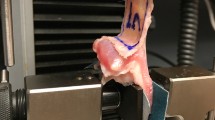Abstract
Purpose
Posterior component separation (PCS) via the transversus abdominis release (TAR) procedure continues to gain popularity. However, neither the physiologic basis nor the extent of myofascial medialization after TAR is established. We aimed to assess both anterior and posterior rectus fascia (AF and PF) medialization following each step of the TAR procedure.
Methods
Ten fresh cadavers underwent PCS via TAR. Steps included midline laparotomy (MLL), retrorectus dissection (RRD), incision of the posterior rectus sheath (IPL), transversus abdominis muscle division (TAD), and retromuscular dissection (RMD). Medial advancement of AF and PF was measured following application of 2.5, 5.0 lb, and maximal tension to the fascial edge. Values are represented as mean advancement past midline in centimeters.
Results
MLL allowed advancement of 2.5, 3.7, and 4.9 cm. RRD provided advancement of 4.1, 5.9, and 7.6 cm for AF and 4.4, 6.2, and 7.5 cm for PF. IPL provided advancement of 4.2, 6.1, and 8.0 cm for AF and 4.6, 6.6, and 8.3 cm for PF. TAD provided advancement of 4.5, 6.6, and 8.6 cm for AF and 5.3, 7.5, and 9.5 cm for PF. RMD provided advancement of 5.5, 7.9, and 9.9 cm for AF and 6.9, 9.6, and 11.2 cm for PF. Overall, the complete TAR procedure provided AF advancement of 102% and PF advancement of 129%, over baseline.
Conclusions
The TAR procedure provides for substantial medial advancement of both anterior and posterior myofascial components of the abdominal wall. Retromuscular dissection deep to the divided transversus abdominis muscle appears to be the key step of the procedure, allowing for effective reconstruction of very wide (≈ 20 cm) defects.











Similar content being viewed by others
References
Novitsky YW, Elliott HL, Orenstein SB, Rosen MJ (2012) Transversus abdominis muscle release: a novel approach to posterior component separation during complex abdominal wall reconstruction. Am J Surg 204:709–716. https://doi.org/10.1016/j.amjsurg.2012.02.008
Jones CM, Winder JS, Potochny JD, Pauli EM (2016) Posterior component separation with transversus abdominis release. Plast Reconstr Surg 137:636–646. https://doi.org/10.1097/01.prs.0000475778.45783.e2
Petro CC, Orenstein SB, Criss CN et al (2015) Transversus abdominis muscle release for repair of complex incisional hernias in kidney transplant recipients. Am J Surg. https://doi.org/10.1016/j.amjsurg.2014.08.043
Petro CC, Como JJ, Yee S et al (2015) Posterior component separation and transversus abdominis muscle release for complex incisional hernia repair in patients with a history of an open abdomen. J Trauma Acute Care Surg 78:422–429. https://doi.org/10.1097/TA.0000000000000495
Stoppa R, Petit J, Abourachid H et al (1973) Original procedure of groin hernia repair: interposition without fixation of Dacron tulle prosthesis by subperitoneal median approach. Chirurgie 99:119–123
Rives J, Pire JC, Flament JB et al (1985) Treatment of large eventrations. New therapeutic indications apropos of 322 cases. Chirurgie 111:215–225
Ramirez OM, Ruas E, Dellon AL (1990) “Components separation” method for closure of abdominal-wall defects: an anatomic and clinical study. Plast Reconstr Surg 86:519–526
Novitsky YW, Fayezizadeh M, Majumder A et al (2016) Outcomes of posterior component separation with transversus abdominis muscle release and synthetic mesh sublay reinforcement. Ann Surg. https://doi.org/10.1097/SLA.0000000000001673
Appleton ND, Anderson KD, Hancock K, Scott MH, Walsh CJ (2016) Initial UK experience with transversus abdominis muscle release for posterior components separation in abdominal wall reconstruction of large or complex ventral hernias: a combined approach by general and plastic surgeons. Ann R Coll Surg Engl 99(4):265–270. https://doi.org/10.1308/rcsann.2016.0241
Espinosa-de-los-Monteros A, Avendano-Peza H, Novitsky YW (2016) Abdominal closure after TRAM flap breast reconstruction with transversus abdominis muscle release and mesh. Plast Reconstr Surg Glob Open 4:e1014. https://doi.org/10.1097/GOX.0000000000001014
Krpata DM, Blatnik J, Novitsky YW, Rosen MJ (2012) Posterior and open anterior components separations: a comparative analysis. Am J Surg 203:318–322. https://doi.org/10.1016/j.amjsurg.2011.10.009 discussion 322.
Pauli EM, Wang J, Petro CC et al (2014) Posterior component separation with transversus abdominis release successfully addresses recurrent ventral hernias following anterior component separation. Hernia. https://doi.org/10.1007/s10029-014-1331-8
Timmermans L, De Goede B, Van Dijk SM et al (2014) Meta-analysis of sublay versus onlay mesh repair in incisional hernia surgery. Am J Surg 207:980–988. https://doi.org/10.1016/j.amjsurg.2013.08.030
Funding
No external funding was used for this study.
Author information
Authors and Affiliations
Corresponding author
Ethics declarations
Conflict of interest
AM, HJM, LMD, and HS declare no conflict of interest. YWN declares conflict of interest (consultant for C.R. Bard, Inc, Intuitive Surgical, and Cooper Surgical, Inc.) not directly related to the submitted work.
Ethical approval
Ethical approval was also exempt as this again was a non-living tissue study.
Human and animal rights
This study was IRB exempt as it was with non-living tissue.
Informed consent
No consent was needed as the cadavers had consented to tissue donation for their respective provides.
Rights and permissions
About this article
Cite this article
Majumder, A., Miller, H.J., del Campo, L.M. et al. Assessment of myofascial medialization following posterior component separation via transversus abdominis muscle release in a cadaveric model. Hernia 22, 637–644 (2018). https://doi.org/10.1007/s10029-018-1771-7
Received:
Accepted:
Published:
Issue Date:
DOI: https://doi.org/10.1007/s10029-018-1771-7




